THE MAGNETIC SUN
The Sun is a magnetic star. The thermonuclear furnace in its 15-million-degree core heats and churns the electrically conducting plasma in the outer third of the Sun in much the same way as a stove heats and churns boiling water. This part of the Sun is called the convective zone. Plasma in motion drives a dynamo that generates a global magnetic field as well as smaller-scale local fields. As these magnetic fields emerge through the Sun’s visible surface (the photosphere), they form sunspots and other active regions and create complex and dynamic plasma structures in the Sun’s upper atmosphere (corona). The Sun’s magnetic fields store enormous amounts of energy, which can be released gradually or explosively. Explosive energy release occurs in flares and coronal mass ejections (CMEs). Flares are intense releases of energy in the form of electromagnetic radiation and energetic particles; CMEs are transient events in which huge quantities of coronal plasma and magnetic fields are propelled into the heliosphere, sometimes at initial speeds in excess of 1,000 kilometers per second.
The Sun’s magnetic activity increases and decreases in a nearly regular cycle, as is seen in the rise and fall of the number of sunspots every 11 years. (Shaped by intense, local magnetic activity, sunspots are somewhat
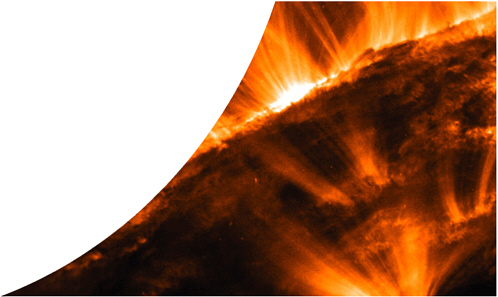
Magnetic fields emerging from the solar interior organize the Sun’s million-degree corona in a complex architecture of loops, arcades, and filaments.
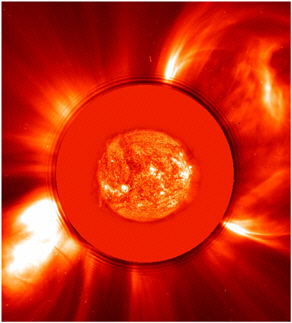
Coronal mass ejections, such as the two seen here heading in opposite directions from the Sun, are the primary drivers of heliospheric and geomagnetic disturbances.
cooler than the surrounding gases, and therefore appear darker.) With increasing magnetic activity, changes occur in the structure of the corona and the solar wind, while CMEs and flares become more frequent. Around the peak of the solar cycle, the Sun’s global magnetic field “flips”—that is, the north magnetic pole becomes the south magnetic pole, and vice versa! Not surprisingly, the Sun’s effect on the solar system ebbs and flows with its magnetic cycle. For example, solar-cycle-driven changes in the structure of the solar wind are thought to cause variations in the shape of the heliospheric “bubble.” Of more immediate concern to us here on Earth is the increase in space weather disturbances during the periods of high solar activity. Such perturbations, and potential impacts on satellites, radio communications, and high-flying humans, are triggered by encounters of fast CMEs with Earth’s magnetic field.
PROBING THE SUN’S INTERIOR
Although the Sun has no solid surface—it is a churning ball of gases—the intense brightness of its photosphere blinds us. So how do we know what is going on inside? The answer: through helioseismology, the study of “sunquakes.” Helioseismology probes the structure and dynamics of the Sun’s interior by observing oscillations on the photosphere. By analyzing the patterns of these oscillations, helioseismologists are able to infer the shape and motions of solar plasma deep in the interior. Helioseismic observations have revealed strong variations in the velocity of the plasma flows at both the base and the top of the convective zone. It is in such layers of differential flow that the Sun’s large-scale magnetic field (lower layer) and small-scale magnetic field (upper layer) are likely to originate. A significant accomplishment of helioseismology, with important ramifications for other fields, is the validation of theoretical models of the Sun’s interior.
THE CORONA AND SOLAR WIND
The wind that inflates the heliosphere, the solar wind, blows continuously. It originates in the several-million-degree solar
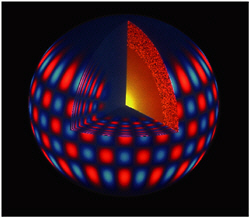
Artist’s concept of the solar oscillations used in helioseismology to probe the Sun’s interior.
corona and is accelerated to supersonic speeds near the Sun by processes scientists still do not fully understand. As the solar wind blows through interplanetary space, it carries embedded in its flow a magnetic field, the interplanetary magnetic field (IMF). Like its coronal source, the solar wind is structured and variable. It changes in density, speed, and temperature, and in the strength and orientation of the IMF. At solar minimum, the heliosphere is dominated by a fast solar wind from the Sun’s high latitudes, whereas during solar maximum it is dominated by a slow and variable wind from all latitudes. This change in the structure of the solar wind reflects the dramatic reconfiguration of the corona that takes place as the Sun’s magnetic field reverses. At the peak of the Sun’s activity cycle, the solar wind is also increasingly disturbed by the passage of CMEs, which occur over 10 times more often at solar maximum than at solar minimum.
Like all solar activity, the solar wind’s energy derives ultimately from the fusion of hydrogen nuclei in the Sun’s core. But it is not known how the solar wind is accelerated to speeds ranging from 300 to 700 kilometers per second—and how its source, the Sun’s corona, is heated to temperatures many hundreds of times hotter than those of the Sun’s visible
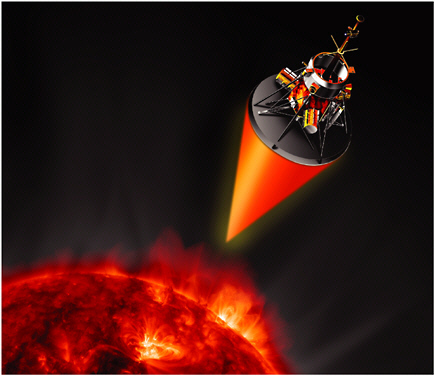
The first spacecraft to explore the near-Sun region, Solar Probe will revolutionize our basic understanding of the expanding solar atmosphere.
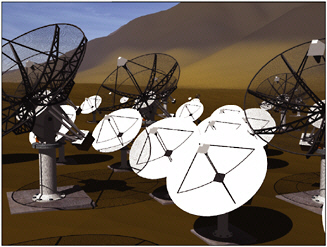
The 100-dish Frequency-Agile Solar Radiotelescope will combine radio imaging and radio spectroscopy to study the solar chromosphere and corona.
surface. Answers to these two fundamental questions will be provided by Solar Probe, a spacecraft that will sample the solar wind and corona in the near-Sun region, one of the last unexplored parts of the solar system and the source of the heliosphere itself. Such measurements will determine how energy flows upward in the solar atmosphere, heating the corona and accelerating the solar wind, and will also reveal how the wind evolves with distance in the inner heliosphere.
How energy stored in solar magnetic fields is explosively released in flares and CMEs is also poorly understood and is one of the key questions to be answered by the Frequency-Agile Solar Radiotelescope (FASR), the Survey Committee’s top ground-based solar physics initiative. FASR is a revolutionary new observational tool that combines radio imaging and radio spectroscopy to study energy release in flares and CMEs, the three-dimensional structure of the solar atmosphere, and the magnetic fields that thread the corona.
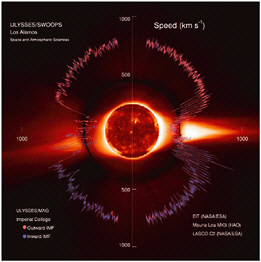
Ulysses measurements of solar wind speed, plotted as a function of latitude, clearly show the bimodal character of the solar wind around solar minimum: a fast wind from polar coronal holes and a slow wind from the low-latitude streamer belt.




